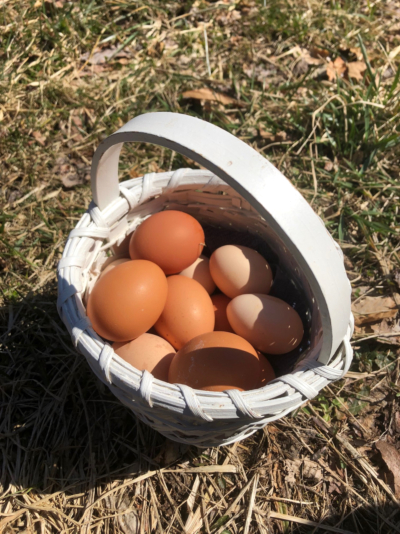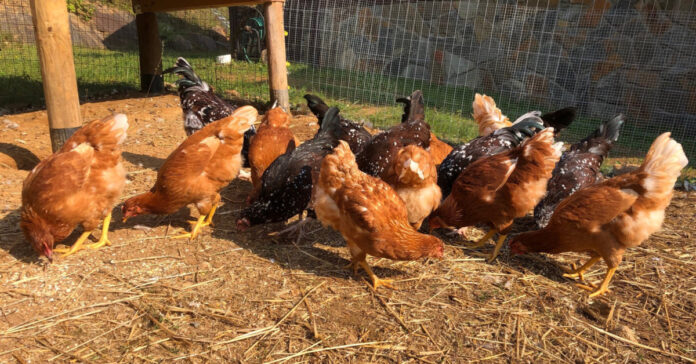My wife surprised me by suggesting that I might want to get a few more chickens. We have 13 hens and get 12 to 13 eggs per day. On average, we eat two dozen eggs per week, sell four dozen, and give one or two dozen to family or friends.
I had considered buying six chicks this year so I could rotate the flock and ensure we always have some fresh, highly productive layers. Buying six new chicks each year would allow us to cull the six least-productive hens every fall. (It is cheaper to keep chickens in the summer than in the winter when they consume more calories, so I would want to cull them before the cold set in.) With the coming food shortage, I’m thinking more eggs might be valuable.
I would prefer to raise my own chicks, however, and I am waiting for one or more of my Speckled Sussex hens to get broody. Then we can see if she has any success hatching her own eggs and raising her own chicks.
Incubator Options
I could harvest eggs and put them in an incubator, but that defeats the whole premise of being self-sustaining, a good goal for a prepper. I want proof our chickens can successfully hatch and raise chicks without outside interference. I’d rather find out if my hens are bad mothers now, when the option of buying day-old chicks still exists, rather than after TEOTWAWKI.
If none of my chickens get broody by mid-June, I may look into an incubator instead of buying chicks. Small incubators are available for less than $100. I could break even after hatching two sets of my own eggs instead of buying chicks. Incubators require electricity, so they won’t work in a grid-down situation. They could be useful as food prices rise and we see more shortages, however, as I expect it may soon become hard to find baby chicks.
I have heard of people raising eggs in their incubator and then shoving the newborn chicks under a broody hen. Apparently, this can fool the hen into thinking her eggs hatched and she will raise the chicks. That might be a fallback plan if they my hens are not successful in hatching their own eggs.
When raising your own chicks, you will get roosters in addition to hens. That’s OK, after eight or ten weeks, when they are nice and plump, you can send them off to “freezer camp.” It might be a good way to supplement your food supply as meat prices increase. I don’t think we would object to an additional six or eight chickens in the freezer.
I would not want to raise more than two batches of chicks per year because of our short warm season. Adding pullets to our outdoor coop in the cold weather would not work out too well.
Chickens and Self Sufficiency
I recommend chickens for preppers and anyone else worried about food security, even those who live in cities or suburbs. You may even be able to raise half a dozen or more if you have a small backyard. If you don’t get a rooster, chickens are relatively quiet and should not bother neighbors. Just start soon. I expect there will be a shortage of both pre-fabricated chicken coops and chicks due to demand.
In a prepping situation, having a fresh daily source of protein and fat will be very useful. At our house, we could eat two eggs each for breakfast and again for dinner and still have extras. Or, we could feed six people two eggs per day. That’s 140 calories and 10 grams of protein.
Eggs are very versatile and you rarely meet anyone who doesn’t like eggs.
While people tend to think of cooking scrambled or fried eggs, you can make an omelet, French toast, use eggs in baked goods, or add them to meatloaf or a casserole. Don’t forget hard boiling, soft-boiling, or poaching them. You can make egg drop soup or throw two eggs in boiling water with a packet of Ramen and poach the eggs in its water, increasing the protein and fat in what is otherwise pretty carb-heavy meal. If you store rice (and you should), you can add eggs and make fried rice or rice cakes.
The Economics of Chickens
Although we had start-up costs, our chickens are currently paying for themselves. Here’s how that math works out: Right now, a dozen eggs from commercially raised free-range chickens cost more than $5 in our local grocery store. They occasionally go on sale for $4. Eggs from small, local farms sell for $7 per dozen at the closest farmer’s market. This means we are saving anywhere from $8 to $14 per week by not buying eggs.

We sell our eggs for $5 per dozen, and if we make $15 in sales per week, we break even on consumables. Consumables include about half a gallon of feed and a cup of scratch per day, plus grit and bedding. So between our savings and our sales, we’re coming out $25 ahead. With the way food inflation is going, that could be $40 or more by summer.
We did not go into raising chickens intending to make money; we did it to be more self-sufficient and provide a steady source of food for good times and bad. That’s a good thing, because while we may make a few extra dollars every week, when you add in the cost of feeding chickens for four or five months before they lay their first egg, you can see that it takes some time to turn an actual profit. Add in the cost of waterers, nesting boxes, feed trays, building the coop and installing the fence, and it will be years before we make money. If you already have a shed or other structure that can serve as a coop, you can probably reach profitability sooner.
My experience is proof it is possible to raise chickens to feed your family and have a few eggs to barter or sell and come out ahead financially. Of course, you also come out ahead when eggs are in short supply at the store, but not at your house.
The Breed Matters
If you are raising chickens for eggs, I cannot over emphasize how important it is to get a breed of chickens that is an excellent layer. Many traditional breeds lay eggs for 200 or fewer days per year. They slow down and even stop laying during the winter. Our Red Star chickens lay an egg 350 days per year. They also lay larger eggs than our Speckled Sussex, and the eggs appear to have a thicker shell. These little gals are egg-laying machines.
You may ask, why have anything else? First, the Red Stars are not known for brooding and are unlikely to raise their own chicks. Our Speckled Sussex, on the other hand, are known for being broody, as are several other traditional breeds, such as the Buff Orpington. Many of these traditional breeds are also mixed use birds, meaning they will put on enough weight to be good meat birds, even though it will take them twice as long as a dedicated meat bird.
When picking our chickens, I looked for chickens that were good foragers, were cold tolerant and laid brown eggs. Then I bought eight Red Stars, which are high-volume layers, and four Speckled Sussex females and four males. (It turned out to be 5 females and 3 males, because it’s difficult to tell the sex of newborn chicks.)
In Praise of Roosters
Roosters are loud, and it isn’t just when the sun rises. They will crow intermittently through the day. Some days, they are loud at 3 a.m. (Those are the days I am glad we have thick log walls.)
Sometimes they can be aggressive. I’ve had to shove one or two with my foot as a warning to back off. I’ve also learned to walk slowly and not turn my back on them when they are puffed up and acting tough.
The plus side of this is that a rooster helps protect the flock. They keep an eye on the ladies, warn them to run under cover when a hawk flies over, and will fight off predators. Their spurs, which take about a year to fully develop, can be dangerous weapons, and they won’t hesitate to tackle a hawk or other predator that wants a chicken dinner.
Beyond their protective nature, having a rooster is a necessity for preppers. How else will you have fertilized eggs and be able to raise new chickens? Over the years, the amount of eggs your hens will produce declines. After two years, many are past their prime and egg production may decrease. After three or four years, they may give you little or no eggs at all. In a long-term survival situation, you need to be able to raise new chickens to replenish your flock. Also, don’t underestimate the value of selling or bartering fertilized eggs or young chickens.
Hens will lay eggs even if there is no rooster around, but unfertilized eggs will not produce chicks. If your area prohibits roosters, you’ll need to buy chick or fertilized eggs from someone with a rooster when it comes time to replenish your flock.
Stay Tuned
I’ll let you know if we get a broody hen or end up going with the incubator. Either way, you can follow our progress here.







